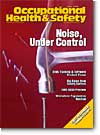
June 2005
Cover Story
By Jeffrey Birkner
NOISE is a particularly insidious hazard. It can be enjoyable and hazardous at the same time. The effect that it has on our hearing generally depends on how long we have been exposed to the noise and how loud the sound is.
Features
By Jerry Laws
Editor's note: Ninety percent of safety managers understand the need for proactive behavior based safety recognition, but many of them find their recognition strategy is still the old school, says Bill Sims, Jr., president of Bill Sims Award of Excellence in Columbia, S.C.
By Tarek Fouad
NEVER before have communication interoperability and information sharing among intelligence and law enforcement agencies been as critical as they are in this post-9/11 world.
By Bill Sokol
RECENT years have seen rapid developments in the number and types of products available to provide hearing protection as mandated by OSHA in 29 CFR 1910.95(b)(1). Not only has the design of hearing protection devices (HPDs) evolved, but the technology and materials used in their construction have advanced, as well.
By Fred A. Manuele
THIS paper will establish that two age-old beliefs, often applied, are barriers to inquiry into the reality of systemic design and engineering, operational, and cultural causal factors for incidents resulting in serious injury.
By Tim Hoffman
CITING employees as a company's most valuable asset is so common today that it borders on cliché. Every organization, it seems, claims it as a management philosophy, but few actually live it.
By Jerry Laws
Editor's note: Skanska USA Building Inc. (www.skanskausa.com) of Parsippany, N.J., has tied IFE into incentive bonuses for its six Co-Chief Operating Officers who oversee company operations, the Account Managers who report to them, and each AM's project teams.
By Allan Shelly
GOOD ergonomics is good business. According to a November 2003 productivity study in the Journal of the American Medical Association (JAMA), lost productive time from common pain conditions among active U.S. workers costs an estimated $61.2 billion per year while at work and in work-related absences.
By Ron A. Kirsch, Ph.D.
AT the end of the day, the goal of occupational health and safety professionals is not only to keep all employees safe, healthy, and on the job, but also to send them home safe and sound to their families and loved ones. Getting to that goal has sparked numerous debates and philosophical discussions over the years.
By Larry Garner
PROTECTING our quality of life is dependent upon how well we identify potential risks and apply our knowledge of the five basic types of hand protection.
By C. J. Palmer, NREMT-P
SUDDEN cardiac arrest takes more than 460,000 lives in the United States each year. Despite prompt recognition of the event and immediate CPR, survival rates of less than 5 percent are still commonplace.
THE number one cause of safety incidents isn't sprains, strains, repetitive motion injuries' or any other line item on a monthly incident report. It's a lack of commitment to safe work practices. No matter how you slice your safety statistics, virtually all injuries at any company are preventable with the right preparation and focus.
By Dave Roll
OSHA has adopted the most recent ANSI Z87.1-2003 Standard, Practice for Occupational and Educational Eye and Face Protection. It is imperative that employers know the standard and comply with OSHA directives.
Departments
By Jerry Laws
WHY am I pondering the cost of U.S. firefighters' injuries? The bottom line of a sincere, recent effort to count these injuries and estimate their cost is no great shock to me: There is no clear bottom line.
By Ronnie Rittenberry
IT'S not exactly rocket science, but close enough. Launched recently by Unique Logic and Technology Inc. (ULT) of Asheville, N.C., a computer-based training program named Play Attention Adult® (PA2) focuses on one of the all-important yet least-delved aspects of occupational safety and health: paying attention.